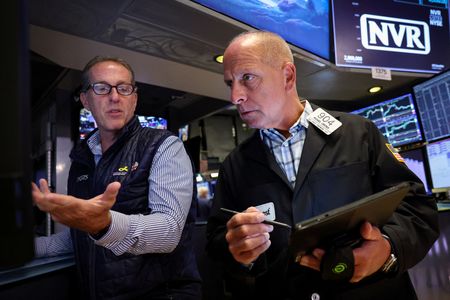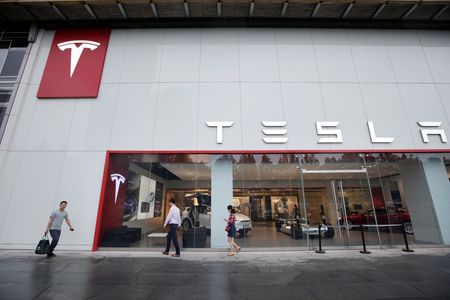(Refiles to correct spelling of Macron’s first name in paragraph 12)
By Jamie McGeever
ORLANDO, Florida (Reuters) -TRADING DAY
Making sense of the forces driving global markets
By Jamie McGeever, Markets Columnist
Many world markets took a breather on Monday as investors awaited the outcome of U.S. President Donald Trump’s extraordinary meetings with Ukraine’s Volodymyr Zelenskiy and many European leaders, and looked ahead to Fed Chair Jerome Powell’s keynote speech in Jackson Hole later in the week.
More on that below. In my column today I ask whether U.S. consumer spending can be sustained, which would keep the economy growing and steer it away from recession. Much will depend on how the rich feel about their finances.
If you have more time to read, here are a few articles I recommend to help you make sense of what happened in markets today.
1. Powell has used Jackson Hole to battle inflation andbuoy jobs; he’s now caught between both 2. What US stagflation risks mean for world markets 3. Eerily calm credit markets face pockets of concern: MikeDolan 4. Japan says US is not pressuring BOJ for rate hikes,markets not so sure 5. China’s half-cooked growth plan is going cold
Today’s Key Market Moves
* STOCKS: Australian stocks hit new highs and Chinesestocks hit 10-year peaks, but otherwise it’s quiet. WallStreet’s big three indices close essentially flat. * SHARES/SECTORS: HR management software firm Dayforcejumps 26% on news it is the subject of a private equity bid.Intel down 3.7% on a report the Trump administration is in talksto take a 10% stake in it. * FX: Very quiet in G10 FX, with the yen the biggestdecliner. Beijing fixes the yuan at 7.1322/$, its strongestsince Nov. 6. Brazil’s real is among the worst-performingcurrencies in the world, down 0.6%. * BONDS: 30-year yields rise around the world – US 2-weekhigh, Japan 3-week high, Germany 14-year high. Meanwhile, allseems calm in U.S. credit – corporate bond spreads tightestsince 1988. * COMMODITIES: Oil prices rise around 1%. Brent crudefutures settle at $66.60/bbl, WTI crude at $63.42/bbl.
Today’s Talking Points:
* Europe goes to Washington. U.S. President Donald Trump’s intense, hastily-arranged summitry continued on Monday as he welcomed Ukraine’s President Volodymyr Zelenskiy to the White House to discuss how to end the Ukraine-Russia war. This follows Trump’s meeting with Vladimir Putin in Alaska on Friday, which was a success for the Russian president but yielded little for Trump.
And that meant little for Ukraine or Europe, which explains the extraordinary sight of Zelenskiy being backed in Washington on Monday by many of Europe’s most powerful leaders, including Germany’s Friedrich Merz, France’s Emmanuel Macron, Britain’s Keir Starmer and NATO’s Mark Rutte.
Trump’s appearance with Zelenskiy before the cameras was cordial and even friendly, in stark contrast to their acrimonious meeting in February. Trump said the U.S. would help Europe in providing security for Ukraine as part of any deal, but also suggested to reporters that he no longer believed a ceasefire was a necessary prerequisite for striking a peace agreement.
* Jackson Hole. Attention is now turning to the annual Kansas City Fed’s symposium in Jackson Hole, Wyoming, which gathers Fed officials, central bankers and leading economists from around the world to discuss the challenges facing the global economy. Fed Chair Jerome Powell’s speech on Friday is the keynote event.
Leaving aside any possible long-term policy steers, such as changes to QT or tolerating slightly higher inflation, the main focus is whether he leans toward a rate cut in September or not.
Rates traders still think he will, but their conviction is ebbing by the day. They are now attaching an 82% probability of a quarter-point cut next month, the lowest likelihood since the unexpectedly weak employment data on August 1.
* Long-end bond blues. Yields on 30-year sovereign bonds in major countries around the world continue to rise. In some cases, like that of Germany, they are now the highest in many years as investors begin to fret again about inflation and fiscal spending plans.
Many investors are also questioning the wisdom of the Fed resuming its easing cycle next month, which is what’s currently priced into rates futures markets, with inflation above target, unemployment at a historical low, stocks at record highs and financial conditions the loosest in years.
Even the long end of China’s bond market is feeling the squeeze. The 30-year yield spiked 8 basis points to 2.12% on Monday, the highest in five months and biggest one-day rise since October. And this is in China, where the deflationary pressures of the last few years are showing no sign of lifting.
Can the rich continue to prop up US consumer spending?
U.S. consumer spending’s surprising resilience is the main reason the economy has not only avoided recession, but continued to grow at a solid clip. The big question now is whether American households can keep that going, especially with higher, tariff-fueled prices coming down the pike.
In the U.S., “the consumer” is king. Consumer spending accounts for around 70% of total economic output, so changes in people’s propensity to spend have a direct, outsized influence on the health of the economy.
But “the consumer” is, of course, actually millions of people. And when you split them into groups based on income and wealth, it becomes clear that total spending disproportionately comes from the rich.
Mark Zandi, chief economist at Moody’s Analytics, said earlier this year that the richest 10% of Americans, those earning at least $250,000 a year, now account for half of all consumer spending. That’s a record. Thirty years ago, the richest 10% accounted for 36% of all consumer spending.
A Boston Fed paper last week backed up Zandi’s findings, concluding that the strength of aggregate consumer spending in the last three years is due to high-income earners. But the authors suggest high-income consumers have a reasonable cushion because they haven’t maxed out their credit cards.
While the lower-income and middle-income cohorts both saw their credit card debt soar past pre-pandemic totals in the last few years, wealthier Americans’ credit card debt remains below the 2019 high and well below the level implied by the pre-pandemic trend. So, if necessary, they still have room to borrow to fund their spending.
EARNING POWER
Spending across the income deciles could also be supported by enhanced earning power.
While some indicators show that the U.S. labor market may be softening, annual average earnings growth still rose in July to 3.9%, meaning real wage growth is running at a 1.3% annual pace, depending on what slice of inflation you use. Real annual wage growth has been between 1.0% and 1.8% for over two years, above the average for the decade leading into the COVID-19 health crisis.
And overall workers’ income may be growing at an even faster rate, according to economists at Bank of America. They calculate that aggregate labor income – number of jobs multiplied by wages multiplied by number of hours worked – increased 5.5% in July on a six-month annualized basis. Most of that growth was driven by higher wages.
With household delinquency rates, excluding student loans, cooling off this year, strength in labor income should continue to support consumer spending, they argue. This, in turn, should help the U.S. avoid the recessionary spiral of lower spending begetting layoffs, begetting even lower spending, begetting more job cuts.
This is one of the reasons BofA economists retain their out-of-consensus call that the Federal Reserve won’t cut interest rates at all this year.
FLASHING AMBER?
Others are less confident.
Zandi at Moody’s Analytics warns that a correction on Wall Street would hit the rich hard via the negative wealth effects, “and, given how weak the economy is, push it into recession.”
The concentration of equity ownership at the top of the U.S. wealth ladder is extreme – the richest 1% in the country owns 50% of stock market assets and the top 10% holds around 90%.
Some measures of household spending are already flashing amber. Inflation-adjusted spending as measured by personal consumption expenditures flat lined in the first half of this year.
Yet figures on Friday showed that retail sales rose 0.5% in July after an upwardly revised 0.9% gain in June.
But then there are tariffs. Companies, not consumers, have borne the brunt of these levies so far. Economists at Goldman Sachs estimate that consumers absorbed only 22% of tariff costs through June, but they reckon that figure could rise to 67% in the months ahead if the Trump administration’s expected tariffs are implemented.
So there are grounds for both caution and optimism. Much will depend on whether the rich draw in their horns.
What could move markets tomorrow?
* Australia consumer sentiment (August) * Euro zone current account (June) * Canada inflation (July) * Federal Reserve Vice Chair for Supervision Michelle Bowmanspeaks * U.S. earnings – Home Depot, Palo Alto Networks
Want to receive Trading Day in your inbox every weekday morning? Sign up for my newsletter here.
Opinions expressed are those of the author. They do not reflect the views of Reuters News, which, under the Trust Principles, is committed to integrity, independence, and freedom from bias.
(By Jamie McGeever; Editing by Deepa Babington)










